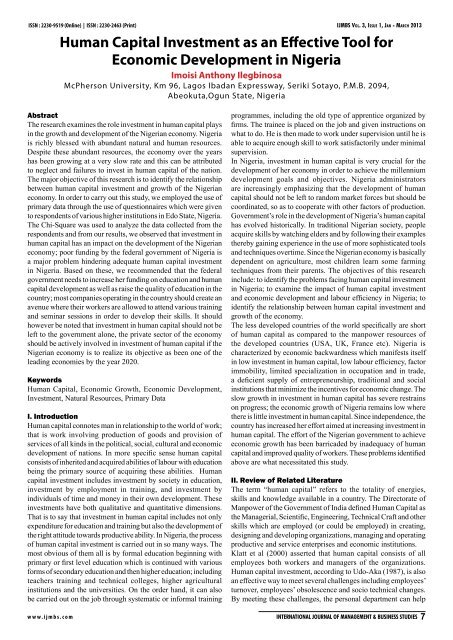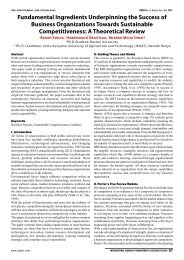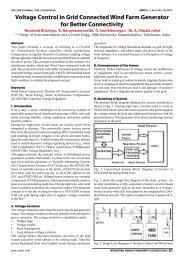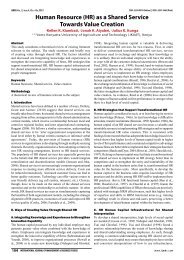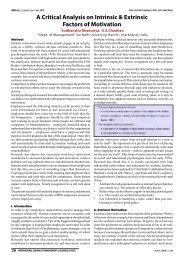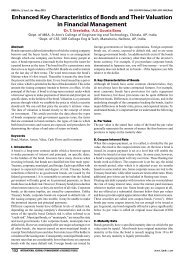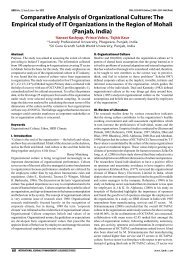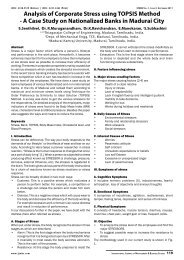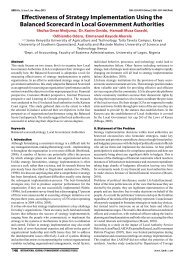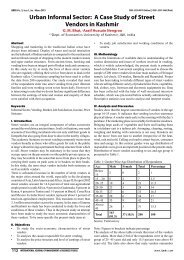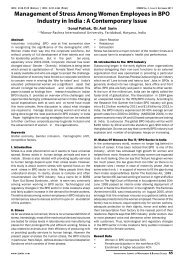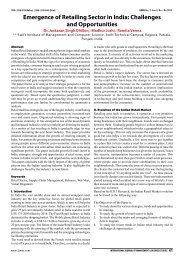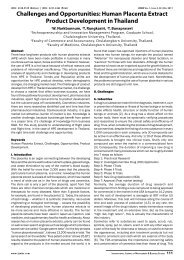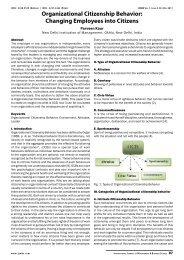Human Capital Investment as an Effective Tool for ... - Ijmbs.com
Human Capital Investment as an Effective Tool for ... - Ijmbs.com
Human Capital Investment as an Effective Tool for ... - Ijmbs.com
You also want an ePaper? Increase the reach of your titles
YUMPU automatically turns print PDFs into web optimized ePapers that Google loves.
IJMBS Vo l . 3, Is s u e 1, Ja n - Ma r c h 2013<br />
ISSN : 2230-9519 (Online) | ISSN : 2230-2463 (Print)<br />
<strong>Hum<strong>an</strong></strong> <strong>Capital</strong> <strong>Investment</strong> <strong>as</strong> <strong>an</strong> <strong>Effective</strong> <strong>Tool</strong> <strong>for</strong><br />
Economic Development in Nigeria<br />
Imoisi Anthony Ilegbinosa<br />
McPherson University, Km 96, Lagos Ibad<strong>an</strong> Expressway, Seriki Sotayo, P.M.B. 2094,<br />
Abeokuta,Ogun State, Nigeria<br />
Abstract<br />
The research examines the role investment in hum<strong>an</strong> capital plays<br />
in the growth <strong>an</strong>d development of the Nigeri<strong>an</strong> economy. Nigeria<br />
is richly blessed with abund<strong>an</strong>t natural <strong>an</strong>d hum<strong>an</strong> resources.<br />
Despite these abund<strong>an</strong>t resources, the economy over the years<br />
h<strong>as</strong> been growing at a very slow rate <strong>an</strong>d this c<strong>an</strong> be attributed<br />
to neglect <strong>an</strong>d failures to invest in hum<strong>an</strong> capital of the nation.<br />
The major objective of this research is to identify the relationship<br />
between hum<strong>an</strong> capital investment <strong>an</strong>d growth of the Nigeri<strong>an</strong><br />
economy. In order to carry out this study, we employed the use of<br />
primary data through the use of questionnaires which were given<br />
to respondents of various higher institutions in Edo State, Nigeria.<br />
The Chi-Square w<strong>as</strong> used to <strong>an</strong>alyze the data collected from the<br />
respondents <strong>an</strong>d from our results, we observed that investment in<br />
hum<strong>an</strong> capital h<strong>as</strong> <strong>an</strong> impact on the development of the Nigeri<strong>an</strong><br />
economy; poor funding by the federal government of Nigeria is<br />
a major problem hindering adequate hum<strong>an</strong> capital investment<br />
in Nigeria. B<strong>as</strong>ed on these, we re<strong>com</strong>mended that the federal<br />
government needs to incre<strong>as</strong>e her funding on education <strong>an</strong>d hum<strong>an</strong><br />
capital development <strong>as</strong> well <strong>as</strong> raise the quality of education in the<br />
country; most <strong>com</strong>p<strong>an</strong>ies operating in the country should create <strong>an</strong><br />
avenue where their workers are allowed to attend various training<br />
<strong>an</strong>d seminar sessions in order to develop their skills. It should<br />
however be noted that investment in hum<strong>an</strong> capital should not be<br />
left to the government alone, the private sector of the economy<br />
should be actively involved in investment of hum<strong>an</strong> capital if the<br />
Nigeri<strong>an</strong> economy is to realize its objective <strong>as</strong> been one of the<br />
leading economies by the year 2020.<br />
Keywords<br />
<strong>Hum<strong>an</strong></strong> <strong>Capital</strong>, Economic Growth, Economic Development,<br />
<strong>Investment</strong>, Natural Resources, Primary Data<br />
I. Introduction<br />
<strong>Hum<strong>an</strong></strong> capital connotes m<strong>an</strong> in relationship to the world of work;<br />
that is work involving production of goods <strong>an</strong>d provision of<br />
services of all kinds in the political, social, cultural <strong>an</strong>d economic<br />
development of nations. In more specific sense hum<strong>an</strong> capital<br />
consists of inherited <strong>an</strong>d acquired abilities of labour with education<br />
being the primary source of acquiring these abilities. <strong>Hum<strong>an</strong></strong><br />
capital investment includes investment by society in education,<br />
investment by employment in training, <strong>an</strong>d investment by<br />
individuals of time <strong>an</strong>d money in their own development. These<br />
investments have both qualitative <strong>an</strong>d qu<strong>an</strong>titative dimensions.<br />
That is to say that investment in hum<strong>an</strong> capital includes not only<br />
expenditure <strong>for</strong> education <strong>an</strong>d training but also the development of<br />
the right attitude towards productive ability. In Nigeria, the process<br />
of hum<strong>an</strong> capital investment is carried out in so m<strong>an</strong>y ways. The<br />
most obvious of them all is by <strong>for</strong>mal education beginning with<br />
primary or first level education which is continued with various<br />
<strong>for</strong>ms of secondary education <strong>an</strong>d then higher education; including<br />
teachers training <strong>an</strong>d technical colleges, higher agricultural<br />
institutions <strong>an</strong>d the universities. On the order h<strong>an</strong>d, it c<strong>an</strong> also<br />
be carried out on the job through systematic or in<strong>for</strong>mal training<br />
programmes, including the old type of apprentice org<strong>an</strong>ized by<br />
firms. The trainee is placed on the job <strong>an</strong>d given instructions on<br />
what to do. He is then made to work under supervision until he is<br />
able to acquire enough skill to work satisfactorily under minimal<br />
supervision.<br />
In Nigeria, investment in hum<strong>an</strong> capital is very crucial <strong>for</strong> the<br />
development of her economy in order to achieve the millennium<br />
development goals <strong>an</strong>d objectives. Nigeria administrators<br />
are incre<strong>as</strong>ingly emph<strong>as</strong>izing that the development of hum<strong>an</strong><br />
capital should not be left to r<strong>an</strong>dom market <strong>for</strong>ces but should be<br />
coordinated, so <strong>as</strong> to cooperate with other factors of production.<br />
Government’s role in the development of Nigeria’s hum<strong>an</strong> capital<br />
h<strong>as</strong> evolved historically. In traditional Nigeri<strong>an</strong> society, people<br />
acquire skills by watching elders <strong>an</strong>d by following their examples<br />
thereby gaining experience in the use of more sophisticated tools<br />
<strong>an</strong>d techniques overtime. Since the Nigeri<strong>an</strong> economy is b<strong>as</strong>ically<br />
dependent on agriculture, most children learn some farming<br />
techniques from their parents. The objectives of this research<br />
include: to identify the problems facing hum<strong>an</strong> capital investment<br />
in Nigeria; to examine the impact of hum<strong>an</strong> capital investment<br />
<strong>an</strong>d economic development <strong>an</strong>d labour efficiency in Nigeria; to<br />
identify the relationship between hum<strong>an</strong> capital investment <strong>an</strong>d<br />
growth of the economy.<br />
The less developed countries of the world specifically are short<br />
of hum<strong>an</strong> capital <strong>as</strong> <strong>com</strong>pared to the m<strong>an</strong>power resources of<br />
the developed countries (USA, UK, Fr<strong>an</strong>ce etc). Nigeria is<br />
characterized by economic backwardness which m<strong>an</strong>ifests itself<br />
in low investment in hum<strong>an</strong> capital, low labour efficiency, factor<br />
immobility, limited specialization in occupation <strong>an</strong>d in trade,<br />
a deficient supply of entrepreneurship, traditional <strong>an</strong>d social<br />
institutions that minimize the incentives <strong>for</strong> economic ch<strong>an</strong>ge. The<br />
slow growth in investment in hum<strong>an</strong> capital h<strong>as</strong> severe restrains<br />
on progress; the economic growth of Nigeria remains low where<br />
there is little investment in hum<strong>an</strong> capital. Since independence, the<br />
country h<strong>as</strong> incre<strong>as</strong>ed her ef<strong>for</strong>t aimed at incre<strong>as</strong>ing investment in<br />
hum<strong>an</strong> capital. The ef<strong>for</strong>t of the Nigeri<strong>an</strong> government to achieve<br />
economic growth h<strong>as</strong> been barricaded by inadequacy of hum<strong>an</strong><br />
capital <strong>an</strong>d improved quality of workers. These problems identified<br />
above are what necessitated this study.<br />
II. Review of Related Literature<br />
The term “hum<strong>an</strong> capital” refers to the totality of energies,<br />
skills <strong>an</strong>d knowledge available in a country. The Directorate of<br />
M<strong>an</strong>power of the Government of India defined <strong>Hum<strong>an</strong></strong> <strong>Capital</strong> <strong>as</strong><br />
the M<strong>an</strong>agerial, Scientific, Engineering, Technical Craft <strong>an</strong>d other<br />
skills which are employed (or could be employed) in creating,<br />
designing <strong>an</strong>d developing org<strong>an</strong>izations, m<strong>an</strong>aging <strong>an</strong>d operating<br />
productive <strong>an</strong>d service enterprises <strong>an</strong>d economic institutions.<br />
Klatt et al (2000) <strong>as</strong>serted that hum<strong>an</strong> capital consists of all<br />
employees both workers <strong>an</strong>d m<strong>an</strong>agers of the org<strong>an</strong>izations.<br />
<strong>Hum<strong>an</strong></strong> capital investment, according to Udo-Aka (1987), is also<br />
<strong>an</strong> effective way to meet several challenges including employees’<br />
turnover, employees’ obsolescence <strong>an</strong>d socio technical ch<strong>an</strong>ges.<br />
By meeting these challenges, the personal department c<strong>an</strong> help<br />
www.ijmbs.<strong>com</strong> International Journal of M<strong>an</strong>agement & Business Studies 7
IJMBS Vo l . 3, Is s u e 1, Ja n - Ma r c h 2013 ISSN : 2230-9519 (Online) | ISSN : 2231-2463 (Print)<br />
maintain <strong>an</strong> effective work<strong>for</strong>ce. Robert (1991) noted that of all<br />
the resources, people are the most import<strong>an</strong>t because they are<br />
needed to activate other resources. He said that people are the<br />
main instruments <strong>for</strong> the attainment of the org<strong>an</strong>ization’s goals,<br />
objectives <strong>an</strong>d national building. According to him, the efficiency<br />
with which <strong>an</strong> org<strong>an</strong>ization or economy is operated will depend to<br />
a large extent, on how effectively its hum<strong>an</strong> capital are m<strong>an</strong>aged<br />
<strong>an</strong>d utilized. All activities of <strong>an</strong>y enterprise are initiated <strong>an</strong>d<br />
determined by the people that make up that institution; the pl<strong>an</strong>ts,<br />
offices, <strong>an</strong>d <strong>com</strong>puters automated equipments etc. that a modern<br />
firm uses are unproductive except <strong>for</strong> hum<strong>an</strong> ef<strong>for</strong>t <strong>an</strong>d direction.<br />
<strong>Hum<strong>an</strong></strong> beings design or order the equipment; they secure the<br />
capital needed <strong>an</strong>d fiscal procedures to be used.<br />
Every <strong>as</strong>pect of a firm’s activities is determined by the <strong>com</strong>petence,<br />
moderation <strong>an</strong>d general effectiveness in hum<strong>an</strong> org<strong>an</strong>ization. The<br />
t<strong>as</strong>k of m<strong>an</strong>aging the hum<strong>an</strong> <strong>com</strong>ponent is the central <strong>an</strong>d most<br />
import<strong>an</strong>t t<strong>as</strong>k because all other <strong>com</strong>ponents depend upon how<br />
well it is done. <strong>Hum<strong>an</strong></strong> capital of a nation <strong>com</strong>prises of men <strong>an</strong>d<br />
women, young <strong>an</strong>d old who engage in the production of goods <strong>an</strong>d<br />
services <strong>an</strong>d who are the greatest <strong>an</strong>d indeed the most precious<br />
<strong>as</strong>sets of the nation. Akerele (1991) recognizes that hum<strong>an</strong><br />
capital is the unique element that makes the difference between<br />
one org<strong>an</strong>ization <strong>an</strong>d the others. This is a source of distinctive<br />
<strong>com</strong>petence <strong>for</strong> <strong>an</strong> org<strong>an</strong>ization. The energy, knowledge <strong>an</strong>d skills<br />
of people <strong>for</strong> purely economic purposes are one dimension of<br />
hum<strong>an</strong> endowment which also embraces the thoughts, motives,<br />
beliefs, feelings, <strong>as</strong>pirations <strong>an</strong>d culture of hum<strong>an</strong> beings beyond<br />
<strong>an</strong>d outside the world of work.<br />
Harbison (1973) in his article “<strong>Hum<strong>an</strong></strong> Resources <strong>as</strong> the Wealth<br />
of the Nations”, dramatize the import<strong>an</strong>ce of hum<strong>an</strong> resources<br />
capital development <strong>as</strong> follows: “hum<strong>an</strong> resources, not capital,<br />
in<strong>com</strong>e or material resources constitute the ultimate b<strong>as</strong>is <strong>for</strong><br />
the wealth of nations. <strong>Capital</strong> <strong>an</strong>d natural resources are p<strong>as</strong>sive<br />
factors of production, while hum<strong>an</strong> beings are the active agents<br />
who accumulate capital, exploits natural resources, build social<br />
economic <strong>an</strong>d political org<strong>an</strong>izations <strong>an</strong>d carry <strong>for</strong>ward national<br />
development clearly. A country which is unable to develop the<br />
skills <strong>an</strong>d knowledge of its people <strong>an</strong>d to utilize them effectively in<br />
the national economy will be unable to develop <strong>an</strong>ything else”.<br />
According to Gbosi (2007), there are three types or me<strong>an</strong>s of<br />
investing in hum<strong>an</strong> beings; they are education <strong>an</strong>d training, health<br />
expenditure <strong>an</strong>d research. He further stated that this <strong>as</strong>pect of<br />
investment in hum<strong>an</strong> capital will lead to <strong>an</strong> improvement in the<br />
quality of labour in employment. It will also incre<strong>as</strong>e the qu<strong>an</strong>tity<br />
of labour available <strong>for</strong> work either by reducing the amount of<br />
working times or by reducing the incidence of death among<br />
workers. A country’s accumulation of hum<strong>an</strong> capital is seen<br />
<strong>as</strong> <strong>an</strong> investment decision, where the individual gives up some<br />
proportion of their in<strong>com</strong>e during the period of education <strong>an</strong>d<br />
training in return <strong>for</strong> incre<strong>as</strong>ed future earnings (Blundell, 1999).<br />
While investment in hum<strong>an</strong> beings h<strong>as</strong> been a major source of<br />
growth in adv<strong>an</strong>ced countries, the amount of hum<strong>an</strong> investment<br />
in less developed countries have done little to extend the capacity<br />
of the people to meet the challenges of accelerated development.<br />
It is import<strong>an</strong>t to know that hum<strong>an</strong> capital investment is aimed<br />
at incre<strong>as</strong>ing the productivity of the work <strong>for</strong>ce <strong>an</strong>d efficiency of<br />
labour market institutions. In Nigeria, <strong>as</strong> in other countries, the<br />
government plays a major role in the labour market. Generally,<br />
hum<strong>an</strong> capital investment aims at utilizing the full potential of a<br />
nation’s hum<strong>an</strong> resources.<br />
A. Conceptual Framework of Economic Growth<br />
The study of economic growth c<strong>an</strong> be traced <strong>as</strong> far back <strong>as</strong> the<br />
very beginning of the discipline. This is <strong>as</strong>sumed to have started<br />
in the year 1776 when Adam Smith first published his famous<br />
treaties, “The Wealth of Nations”, which <strong>as</strong> well c<strong>an</strong> be called<br />
the “Economic Growth of Nations” (Todaro, 1980). The concept<br />
of economic growth have been defined <strong>an</strong>d explained by various<br />
scholars. The definitions <strong>an</strong>d expl<strong>an</strong>ations of economic growth<br />
are x-rayed in this section of the review of literature.<br />
Samuelson (1999) noted that economic growth implies the ch<strong>an</strong>ge<br />
in the amount of real output or in<strong>com</strong>e in <strong>an</strong> economy overtime. All<br />
economy grows because it obtains incre<strong>as</strong>ed goods <strong>an</strong>d services,<br />
incre<strong>as</strong>ed resources or uses the resources more efficiently. He<br />
further noted that growth is <strong>as</strong>sociated with raising the living<br />
st<strong>an</strong>dard of the population overtime <strong>an</strong>d incre<strong>as</strong>es in the wealth of<br />
the citizens. He also said that the most <strong>com</strong>monly used me<strong>as</strong>ure<br />
of economic growth is the gross national in<strong>com</strong>e (GNP) <strong>an</strong>d that<br />
economic growth could be express in two ways: <strong>an</strong> incre<strong>as</strong>e in<br />
per capita real GNP or NNP overtime <strong>an</strong>d <strong>an</strong> incre<strong>as</strong>e in total real<br />
GNP or NNP overtime.<br />
According to Todaro (1980), the major <strong>com</strong>ponents of economic<br />
growth in <strong>an</strong>y society are capital accumulation including all new<br />
investments in l<strong>an</strong>d, hum<strong>an</strong> resources, growth in population<br />
although delayed, growth in the labour <strong>for</strong>ce, <strong>an</strong>d technological<br />
progress. He continued <strong>an</strong>d said that capital accumulation results<br />
when some proportion of present in<strong>com</strong>e are saved <strong>an</strong>d invested<br />
in order to augment future outputs <strong>an</strong>d in<strong>com</strong>es. New factories,<br />
machineries, equipments <strong>an</strong>d materials incre<strong>as</strong>e physical capital<br />
stock of a nation (i.e. the total net real value of all physically<br />
productive capital goods) <strong>an</strong>d make it possible <strong>for</strong> exp<strong>an</strong>ded output<br />
levels to be achieved.<br />
Talking about population growth (with the <strong>as</strong>sociated although<br />
delayed incre<strong>as</strong>e in the labour <strong>for</strong>ce), Todaro (1980) said that it<br />
h<strong>as</strong> traditionally been considered a positive factor in stimulating<br />
economic growth. A larger labour <strong>for</strong>ce me<strong>an</strong>s more productive<br />
m<strong>an</strong>power, while a larger overall population incre<strong>as</strong>es the potential<br />
size of domestic markets. In explaining technological progress <strong>as</strong><br />
a factor in economic growth, Todaro (1980) observes that it is the<br />
most import<strong>an</strong>t source of economic growth. In its simplest <strong>for</strong>m<br />
according to him, technological progress c<strong>an</strong> be said to result from<br />
new <strong>an</strong>d improved ways of ac<strong>com</strong>plishing traditional t<strong>as</strong>ks such<br />
<strong>as</strong> growing maize, making clothing or building houses.<br />
Besides, other economists have defined economic growth rate of<br />
some national accounting aggregates usually the Gross National<br />
Product (GNP). Bradley (1989) also referred to economic growth<br />
<strong>as</strong> <strong>an</strong> incre<strong>as</strong>e in output level (real GNP). Emm<strong>an</strong>uel (2000) sees<br />
economic growth <strong>as</strong> the process of augmenting the productive<br />
<strong>for</strong>ces or exp<strong>an</strong>ding productive capacity which is ac<strong>com</strong>plished<br />
through effective mobilization, <strong>as</strong>semblage <strong>an</strong>d m<strong>an</strong>agement of<br />
hum<strong>an</strong>, material <strong>an</strong>d fin<strong>an</strong>cial resources. He also said that it is the<br />
process of sustained rise in material output, so that the physiological<br />
or material needs of m<strong>an</strong> c<strong>an</strong> be continually met <strong>as</strong> they rise.<br />
He further differentiated economic growth from development<br />
economic growth or progress <strong>as</strong> he said it is essential <strong>an</strong>d indeed<br />
<strong>an</strong> indispensable <strong>com</strong>ponent of development, me<strong>an</strong>ing that it is<br />
the only st<strong>an</strong>dard <strong>for</strong> me<strong>as</strong>uring <strong>an</strong>d determining development. He<br />
also said that real development involves a structural tr<strong>an</strong>s<strong>for</strong>mation<br />
of the economy <strong>an</strong>d society permits the self generating <strong>an</strong>d self<br />
perpetuating use <strong>an</strong>d development of the peoples’ potentials.<br />
8 International Journal of M<strong>an</strong>agement & Business Studies<br />
www.ijmbs.<strong>com</strong>
ISSN : 2230-9519 (Online) | ISSN : 2230-2463 (Print)<br />
B. Roles of <strong>Hum<strong>an</strong></strong> <strong>Capital</strong> Development in Economic<br />
Growth in Nigeria<br />
The building of a modern nation is b<strong>as</strong>ed on science <strong>an</strong>d technology,<br />
<strong>an</strong>d to a large extent upon the development of people <strong>an</strong>d the<br />
pl<strong>an</strong>ning of hum<strong>an</strong> activity. Several factors accounts <strong>for</strong> economic<br />
growth of a nation, these include: hum<strong>an</strong> capital, natural resources,<br />
<strong>an</strong>d technological progress etc. But none is more import<strong>an</strong>t <strong>an</strong>d<br />
vital th<strong>an</strong> hum<strong>an</strong> capital; most nations today are development<br />
oriented towards improving the lots of m<strong>an</strong>kind. However, the<br />
relev<strong>an</strong>ce of hum<strong>an</strong> capital to economic growth of Nigeria c<strong>an</strong><br />
never be overestimated.<br />
Economists, according to Harrison <strong>an</strong>d Myers (1964), have long<br />
been aware of the import<strong>an</strong>ce of hum<strong>an</strong> capital development. They<br />
cited the example of Adam Smith who stressed the import<strong>an</strong>ce of<br />
education at various points in his treatise “the wealth of nations”<br />
<strong>an</strong>d specifically included the acquired <strong>an</strong>d useful ability of all<br />
inhabit<strong>an</strong>ts or members of society in his concept of fixed capital<br />
that: “the acquisition of such talents by the main ten<strong>an</strong>cy of the<br />
acquired during his education, study or apprenticeship at ways<br />
cost a real expense, which is a capital fixed <strong>an</strong>d realized <strong>as</strong> it were<br />
in his person. Those talents <strong>as</strong> they are make a part of his future,<br />
so do they likewise of that of the society to which he belongs,<br />
Harrison <strong>an</strong>d Myers (1964).<br />
In this framework, the relev<strong>an</strong>ce of hum<strong>an</strong> capital <strong>for</strong> Nigeria c<strong>an</strong><br />
be seen from the point of view of the need to incre<strong>as</strong>e proportion<br />
of skilled persons in the labour <strong>for</strong>ce towards tr<strong>an</strong>s<strong>for</strong>mation of<br />
the Nigeri<strong>an</strong> economy so <strong>as</strong> to pave way <strong>for</strong> industrial revolution.<br />
Developing a favourable attitude among employees towards the<br />
<strong>com</strong>p<strong>an</strong>y will result in incre<strong>as</strong>ed productivity. Todaro (1980)<br />
<strong>as</strong>serted that investment in hum<strong>an</strong> capital c<strong>an</strong> improve its quality,<br />
<strong>an</strong>d thereby have the same or even a more powerful effect on<br />
production of goods <strong>an</strong>d services. Le<strong>com</strong>ber (1975) argued that<br />
economic growth depends to a large extent upon attentions in<br />
hum<strong>an</strong> behavior patterns because m<strong>an</strong> is the primary catalyst in<br />
the production process, through his m<strong>an</strong>agerial ability, <strong>an</strong>d he is<br />
also a key factor of production through his physical (mental) labour<br />
education. The earning (agents of hum<strong>an</strong> capital development)<br />
involve a ch<strong>an</strong>ge in hum<strong>an</strong> behavior <strong>an</strong>d it is there<strong>for</strong>e crucial<br />
to economic growth, both from the individual <strong>an</strong>d the aggregate<br />
st<strong>an</strong>d point.<br />
The once president of Nigeria, His Excellency Olusegun<br />
Ob<strong>as</strong><strong>an</strong>jo in his speech in 1999 stated the need <strong>for</strong> hum<strong>an</strong> capital<br />
especially in a democratic dispensation <strong>as</strong>: “<strong>Hum<strong>an</strong></strong> being is both<br />
the instrument <strong>an</strong>d the ultimate beneficiary of all development<br />
ef<strong>for</strong>ts. Development is about people <strong>an</strong>d democratic government<br />
is also about people. It is very difficult if not impossible <strong>for</strong> <strong>an</strong>y<br />
country <strong>an</strong>d in this c<strong>as</strong>e Nigeria to achieve sustainable growth <strong>an</strong>d<br />
development without the full mobilization <strong>an</strong>d effective utilization<br />
of its hum<strong>an</strong> capital”. The relev<strong>an</strong>ce of hum<strong>an</strong> capital also arose<br />
from the fact that there are emerging ch<strong>an</strong>ges in the fields of<br />
production <strong>an</strong>d marketing in the country. These high m<strong>an</strong>agerial<br />
skills <strong>an</strong>d technical officers are needed in all stages of production<br />
process; it also requires high level skilled m<strong>an</strong>power. Hence,<br />
hum<strong>an</strong> capital development in Nigeria should be given the right<br />
type of pl<strong>an</strong>ning <strong>an</strong>d orientation to be able to place the country<br />
on higher economic pedestal. In the same vein, hum<strong>an</strong> beings are<br />
prime members of innovations <strong>an</strong>d agents of ch<strong>an</strong>ge. To support<br />
this, Harbison (1973) posited that ide<strong>as</strong> <strong>com</strong>e from people <strong>an</strong>d<br />
are put to work by people. However, it is now a <strong>com</strong>mon believe<br />
that the key to economic growth <strong>an</strong>d development in Nigeria<br />
is m<strong>an</strong> hence, the qualities of m<strong>an</strong> <strong>as</strong> a labour <strong>for</strong>ce have to be<br />
pl<strong>an</strong>ned.<br />
IJMBS Vo l . 3, Is s u e 1, Ja n - Ma r c h 2013<br />
C. Problems of <strong>Hum<strong>an</strong></strong> <strong>Capital</strong> <strong>Investment</strong> in Nigeria<br />
Generally, it is always e<strong>as</strong>y to identify problems in <strong>an</strong>y field of<br />
endeavor, <strong>an</strong>d the field of hum<strong>an</strong> capital is one in which problems<br />
must occur. These problems of hum<strong>an</strong> capital in Nigeria <strong>an</strong>d its<br />
consequences or negative effects were noted by Akerele (1991)<br />
<strong>as</strong> the inability to effectively m<strong>an</strong>age the hum<strong>an</strong> factor <strong>an</strong>d to<br />
provide good quality of work life or fair working conditions to<br />
employees that may lead to industrial unrests, strikes, lock out,<br />
work-to-rule <strong>an</strong>d protracted negotiations all with serious effects<br />
on productivity. He further said that the problems of investment<br />
in hum<strong>an</strong> capital include the following: there is poor remuneration<br />
in relationship to profits made by org<strong>an</strong>izations; we notice that<br />
employees arrive at office tired <strong>an</strong>d exhausted <strong>as</strong> a result of poor<br />
tr<strong>an</strong>sport facilities <strong>an</strong>d harsh living conditions in most urb<strong>an</strong> cities;<br />
ineffective training orientation is <strong>an</strong>other problem which is <strong>as</strong> a<br />
result of m<strong>an</strong>agers sending their staff to training programmes<br />
without prior identification of training needs; most often injustice<br />
<strong>an</strong>d corruption takes place in the recruitment process of most<br />
org<strong>an</strong>izations <strong>an</strong>d m<strong>an</strong>agement of our hum<strong>an</strong> capital in general.<br />
However, our inability to invest in hum<strong>an</strong> beings effectively h<strong>as</strong><br />
led to the poor m<strong>an</strong>agement of resources <strong>as</strong> seen in both public<br />
<strong>an</strong>d private sector in the Nigeri<strong>an</strong> economy today. In-spite of the<br />
recognized hum<strong>an</strong> capital development programmes in Nigeria,<br />
there w<strong>as</strong> a great deal of indiscipline in implementing the pl<strong>an</strong>ned<br />
strategies. For inst<strong>an</strong>ce, the Universal B<strong>as</strong>ic Education (UBE)<br />
scheme w<strong>as</strong> launched without adequate preparations in terms<br />
of school building materials <strong>an</strong>d teachers (the federal ministry<br />
of education 2003). There is no doubt, that there are serious<br />
inadequacies in the current strategies devised to address m<strong>an</strong>power<br />
development needs of the country. This is <strong>as</strong>sociated with<br />
inadequate <strong>an</strong>d uncoordinated m<strong>an</strong>power development pl<strong>an</strong>ning,<br />
poor execution of policy programmes etc. The consequences of<br />
this among others include: low level skilled m<strong>an</strong>power, leading<br />
to unemployment of school leavers <strong>an</strong>d graduates of higher<br />
institutions in Nigeria.<br />
III. Method of Study<br />
This section deals with the method of collecting data, sources<br />
of these data collected <strong>an</strong>d the procedures <strong>for</strong> <strong>an</strong>alyzing the data<br />
collected. It is a systematic way of producing knowledge.<br />
A. Research Design<br />
Here we are going to study the relationship that exists between the<br />
variables outlined <strong>for</strong> our study. Primary data would be employed<br />
<strong>for</strong> this study. Generally, social sciences researches take three<br />
<strong>for</strong>ms: Descriptive, Exploratory <strong>an</strong>d Expl<strong>an</strong>atory. This research<br />
involves the <strong>com</strong>bination of the three, that is, it is concerned with<br />
portraying <strong>an</strong> accurate profile of persons, events or phenomenon.<br />
It will seek to underst<strong>an</strong>d what is happening, to seek new insights<br />
into a phenomenon <strong>an</strong>d l<strong>as</strong>tly, to establish a causal relationship<br />
between investment in hum<strong>an</strong> capital <strong>an</strong>d economic development<br />
in Nigeria.<br />
B. Sources of Data<br />
The data required in this research work w<strong>as</strong> gotten through<br />
questionnaire. A total of 120 questionnaires were issued out to<br />
respondents, which w<strong>as</strong> used to represent the area of study i.e.<br />
University of Benin (UNIBEN), Ambrose Ali University, Ekpoma<br />
<strong>an</strong>d Auchi Polytechnic with <strong>for</strong>ty representing each institution.<br />
www.ijmbs.<strong>com</strong> International Journal of M<strong>an</strong>agement & Business Studies 9
IJMBS Vo l . 3, Is s u e 1, Ja n - Ma r c h 2013 ISSN : 2230-9519 (Online) | ISSN : 2231-2463 (Print)<br />
C. Method of Data Collection<br />
The method of data collection used in this study is questionnaire.<br />
Questionnaire according to Anikpo (2006) is “a list of questions<br />
designed to elicit in<strong>for</strong>mation from respondents by filling in the<br />
<strong>an</strong>swers in spaces provided <strong>for</strong> the purpose”. The questionnaire<br />
is the principal me<strong>an</strong>s <strong>for</strong> generating data. The <strong>for</strong>m of questions<br />
adopted in this questionnaire w<strong>as</strong> close ended. This me<strong>an</strong>s that<br />
none of the questions gave respondents’ the privilege to reveal<br />
their motives <strong>an</strong>d express their views. Close ended questions<br />
were adopted because of the problems of <strong>an</strong>alyzing divergent<br />
opinions. The research questionnaire adopted <strong>for</strong> the study w<strong>as</strong><br />
structured into two segments. The first is concerned with extracting<br />
biographic <strong>an</strong>d demographic data of the respondent; such <strong>as</strong> sex,<br />
age <strong>an</strong>d educational qualifications. Section B consist of questions<br />
which were used in testing the hypothesis of this study, related<br />
to the nature of respondents’ <strong>com</strong>pli<strong>an</strong>ce to investment in hum<strong>an</strong><br />
capital.<br />
D. Method of Data Analysis<br />
The statistical method used <strong>for</strong> data <strong>an</strong>alysis <strong>an</strong>d description of the<br />
responses is the chi-square. Chi-square is a statistical technique<br />
used in testing hypothesis. It is used to draw inference on whether a<br />
group of observed frequencies deviate remarkably from the group<br />
of expected frequencies, the use of chi-square however is done<br />
when the data are in nominal scale or ordinal scale. Generally,<br />
X 2 distribution involves a discrete variable <strong>an</strong>d it is employed<br />
in the <strong>an</strong>alysis of enumeration data. The <strong>for</strong>mula <strong>for</strong> calculating<br />
chi-square is given below <strong>as</strong>:<br />
Table 2: Number of Respondents by Age<br />
Respondents Number of Percentage (%)<br />
Respondents<br />
20 - 25 years 50 41.7<br />
26<br />
– 30 ײ 30 25.0 31<br />
– 35 ײ 15 12.5 36<br />
– 40 ײ 10 8.3 41 <strong>an</strong>d above 15 12.5<br />
Total 120 100%<br />
Source: Researcher’s Survey, 2012.<br />
Out of the 120 respondents that <strong>an</strong>swered the questionnaire in<br />
the three higher institutions, 41.7% (50) of them were in the age<br />
bracket of 20 – 25 years, 25% (30) to 26 – 30 age bracket, 12.5%<br />
(15) to 31 – 35 age bracket, 8.3% (10) to 36 – 40 age bracket <strong>an</strong>d<br />
12.5% (15) belong to 41 <strong>an</strong>d above age bracket.<br />
Table 3: Number of Respondents by Educational Qualification<br />
Respondents<br />
Number of<br />
Respondents<br />
Percentage (%)<br />
SSCE 15 12.5<br />
OND/NCE 30 25.0<br />
HND/B.Sc/B.A 60 50.0<br />
M.A/M.Sc 10 8.3<br />
OTHERS 5 4.2<br />
Total 120 100%<br />
Source: Researcher’s Survey, 2012.<br />
Where, O i<br />
= Observed frequency<br />
E i<br />
= Expected frequency<br />
X 2 = Chi Square<br />
With (R-1) (C-1) degree of freedom<br />
The decision rule is <strong>as</strong> follows: reject the null hypothesis if the<br />
calculated chi-square value is greater to the critical value otherwise<br />
accept null hypothesis.<br />
IV. Data Presentation <strong>an</strong>d Analysis<br />
This involves the presentation <strong>an</strong>d <strong>an</strong>alysis of the responses given<br />
to the questions <strong>as</strong>ked in the questionnaire that w<strong>as</strong> administered<br />
to the three categories of respondents <strong>as</strong> stated earlier.<br />
Table 1: Number of Respondents by Sex<br />
Respondents Number of Percentage (%)<br />
Respondents<br />
Male 80 66.7<br />
Female 40 33.3<br />
Total 120 100%<br />
Source: Researcher’s Survey, 2012.<br />
Out of the 120 respondents that <strong>an</strong>swered the questionnaire in the<br />
three selected higher institutions, 66.7% (80) of them were male<br />
while 33.3% (40) were female.<br />
Out of the 120 respondents that <strong>an</strong>swered the questionnaire in the<br />
three higher institutions, 12.5% (15) h<strong>as</strong> a maximum qualification<br />
of SSCE (Senior School Certificate Examination), 25% (30) were<br />
holders of OND/NCE (Ordinary National Diploma/National<br />
Certificate in Education), 50% (60) were holders of HND/B.<br />
Sc/B.A (Higher National Diploma/Bachelor of Science/Bachelor<br />
of Arts), 8.3% (10) were holders of M.A/M.Sc(M<strong>as</strong>ters of Arts/<br />
M<strong>as</strong>ters of Science) <strong>an</strong>d 4.2% (5) were holders of other degree<br />
(e.g. PhD holders).<br />
Table 4: <strong>Investment</strong> in <strong>Hum<strong>an</strong></strong> <strong>Capital</strong> through Education h<strong>as</strong><br />
made Signific<strong>an</strong>t Impact on Economic Growth <strong>an</strong>d Development<br />
of Nigeria<br />
Respondents UNIBEN AAU AUCHI<br />
EKPOMA POLY<br />
Total<br />
Agreed 25 35 30 90<br />
Disagreed 15 5 10 30<br />
Total 40 40 40 120<br />
Source: Researcher’s Survey, 2012.<br />
From the above table, out of the sample of 120 respondents taken,<br />
75% (90) of the sample respondents agreed that investment in<br />
hum<strong>an</strong> capital through education h<strong>as</strong> made signific<strong>an</strong>t impact on<br />
economic growth <strong>an</strong>d development in Nigeria, while 25% (30) of<br />
the sample respondents disagreed that hum<strong>an</strong> capital investment<br />
through education h<strong>as</strong> made signific<strong>an</strong>t impact on economic<br />
growth <strong>an</strong>d development in Nigeria.<br />
10 International Journal of M<strong>an</strong>agement & Business Studies<br />
www.ijmbs.<strong>com</strong>
ISSN : 2230-9519 (Online) | ISSN : 2230-2463 (Print)<br />
Table 5: Respective Government in Nigeria have not<br />
Funded Education Adequately thus Affecting <strong>Hum<strong>an</strong></strong> <strong>Capital</strong><br />
<strong>Investment</strong><br />
Respondents UNIBEN AAU EKPOMA AUCHI POLY Total<br />
Agreed 20 10 28 58<br />
Disagreed 18 25 10 53<br />
Undecided 2 5 2 9<br />
Total 40 40 40 120<br />
Source: Researcher’s Survey, 2012<br />
The <strong>an</strong>swer gotten from the three categories of the respondents<br />
show that 48.3% i.e. 58 of the respondents agreed that respective<br />
government in Nigeria have not funded education adequately, thus<br />
affecting hum<strong>an</strong> capital investment, 44.1% i.e. 53 disagreed on<br />
the question while 7.3% i.e. 9 respondents were undecided.<br />
Table 6: Respondents’ View on the Notion: “That the Educational<br />
School Curricular is not Structured to Meet the Personnel<br />
Requirements of Nigeria”<br />
Respondents UNIBEN AAU AUCHI<br />
EKPOMA POLY<br />
Total<br />
Agreed 20 18 25 63<br />
Disagreed 11 9 12 32<br />
Undecided 9 13 3 25<br />
Total 40 40 40 120<br />
Source: Researcher’s Survey, 2012.<br />
Out of 120 respondents, 52.5% (63) of the respondents agreed that<br />
the educational curricular is not structured to meet the personnel<br />
requirements of Nigeria, 26.7% (32) of the respondents disagreed<br />
while 20.8% (25) were undecided.<br />
Table 7: Responses to the Statement that “Expenditure on<br />
Education h<strong>as</strong> not made <strong>an</strong>y Improvement on the Existing Stock<br />
of <strong>Hum<strong>an</strong></strong> <strong>Capital</strong> in Nigeria”<br />
Respondents UNIBEN AAU AUCHI<br />
EKPOMA POLY<br />
Total<br />
Agreed 10 12 14 36<br />
Disagreed 28 25 20 73<br />
Undecided 2 3 6 11<br />
Total 40 40 40 120<br />
Source: Researcher’s Survey, 2012.<br />
Out of a total of 120 respondents, 30% (36) of the respondents<br />
agreed that education h<strong>as</strong> not made <strong>an</strong>y improvement on the<br />
existing stock of hum<strong>an</strong> capital in Nigeria, 60.8% (73) of the<br />
respondents disagreed with the statement while 9.2% (6) of the<br />
respondents were undecided.<br />
Table 8: Respondents’ View on the Notion: “That Nigeri<strong>an</strong><br />
Educational Curriculum is not Designed to Promote Industrial<br />
<strong>an</strong>d Agricultural Growth <strong>an</strong>d Development in the country”.<br />
Respondents UNIBEN AAU EKPOMA AUCHI POLY Total<br />
Agreed 11 13 17 41<br />
Disagreed 26 24 19 69<br />
Undecided 3 3 4 10<br />
Total 40 40 40 120<br />
Source: Researcher’s Survey, 2012.<br />
IJMBS Vo l . 3, Is s u e 1, Ja n - Ma r c h 2013<br />
Out of a total of 120 respondents, 34.2% (41) of the respondents<br />
agreed that the Nigeri<strong>an</strong> educational curriculum is not designed<br />
to promote industrial growth <strong>an</strong>d agricultural development in<br />
Nigeria, 57.5% (69) of the respondents disagreed while 8.3%<br />
(10) of the respondents were undecided.<br />
Table 9: Respondent View on the Notion: “Whether Respective<br />
Ef<strong>for</strong>ts of the Government towards <strong>Hum<strong>an</strong></strong> <strong>Capital</strong> <strong>Investment</strong> h<strong>as</strong><br />
made <strong>an</strong>y Signific<strong>an</strong>t Impact on Labour Efficiency in Nigeria”.<br />
Respondents UNIBEN AAU AUCHI<br />
EKPOMA POLY<br />
Total<br />
Agreed 12 18 15 45<br />
Disagreed 20 17 21 58<br />
Undecided 8 5 4 17<br />
Total 40 40 40 120<br />
Source: Researcher’s Survey, 2012.<br />
Out of a total of 120 respondents, 37.5% (45)of the respondents<br />
agreed that the respective ef<strong>for</strong>ts of the government towards<br />
hum<strong>an</strong> capital investment h<strong>as</strong> made signific<strong>an</strong>t impact on labour<br />
efficiency in Nigeria, 48.3% (58) disagreed while 14.2% (17)<br />
were undecided.<br />
A. Test of Hypothesis I<br />
For this research, the following hypothesis is stated in null<br />
<strong>for</strong>m:<br />
H 0<br />
: Poor funding by the government is not responsible <strong>for</strong> the<br />
low development of hum<strong>an</strong> capital.<br />
Responses <strong>as</strong> given in Table 5 were used in testing the above<br />
hypothesis.<br />
Respondents UNIBEN AAU AUCHI<br />
EKPOMA POLY<br />
Total<br />
Agreed 20 10 28 58<br />
Disagreed 18 25 10 53<br />
Undecided 2 5 2 9<br />
Total 40 40 40 120<br />
Source: Researcher’s Survey, 2012.<br />
The degree of freedom = (R-1) (C-1)<br />
Where R = Rows, C = Columns, thus, from the table above:<br />
(3 – 1) (3 – 1) = 4<br />
The observed frequencies (Oi) of the observations:<br />
O 11<br />
= 20, O 12<br />
= 10, O 13<br />
= 28<br />
O 21<br />
= 18, O 22<br />
= 25, O 23<br />
= 10<br />
O 31<br />
= 2, O 32<br />
= 5, O 33<br />
= 2<br />
The nine (9) corresponding expected frequencies (Ei) are <strong>as</strong><br />
follows:<br />
E 11<br />
= 19.3, E 12<br />
= 19.3, E 13<br />
= 19.3<br />
E 21<br />
= 17.7, E 22<br />
= 17.7, E 23<br />
= 17.7<br />
E 31<br />
= 3.00, E 32<br />
= 3.00, E 33<br />
= 3.00<br />
www.ijmbs.<strong>com</strong> International Journal of M<strong>an</strong>agement & Business Studies 11
IJMBS Vo l . 3, Is s u e 1, Ja n - Ma r c h 2013 ISSN : 2230-9519 (Online) | ISSN : 2231-2463 (Print)<br />
Table 10: Computation of the Calculated Chi Square Table (Cal<br />
X 2 )<br />
Table 11: Computation of the Calculated Chi Square Table (Cal<br />
X 2 )<br />
Source: Researcher’s Computation.<br />
From the chi-square table, since the calculated X2 (i.e. 16.955) is<br />
greater th<strong>an</strong> tabulated X2 (i.e. 9.488), we reject the null hypothesis<br />
(H0) <strong>an</strong>d accept the alternative hypothesis (H1). There<strong>for</strong>e, we<br />
conclude that poor funding by the government is responsible <strong>for</strong><br />
the low development of hum<strong>an</strong> capital in Nigeria.<br />
B. Test of Hypothesis II<br />
H O<br />
: Ef<strong>for</strong>ts of the respective governments towards hum<strong>an</strong> capital<br />
investment have not made <strong>an</strong>y signific<strong>an</strong>t impact on labour<br />
efficiency in Nigeria.<br />
Responses <strong>as</strong> given in Table 9 were used in testing the above<br />
hypothesis.<br />
Respondents UNIBEN AAU AUCHI<br />
EKPOMA POLY<br />
Total<br />
Agreed 12 18 15 45<br />
Disagreed 20 17 21 58<br />
Undecided 8 5 4 17<br />
Total 40 40 40 120<br />
Source: Researcher’s Survey, 2012.<br />
The degree of freedom = (R-1) (C-1)<br />
Where R =Rows, C = Columns, thus from the table above<br />
(3 – 1) (3 – 1) = 4<br />
The observed frequencies (O1) of the observations:<br />
O 11<br />
= 12, O 12<br />
= 18, O 13<br />
= 15<br />
O 21<br />
= 20, O 22<br />
= 17, O 23 = 21<br />
O 31<br />
= 8, O 32<br />
= 5, O 33<br />
= 4<br />
The corresponding expected frequencies (E 1<br />
) are <strong>as</strong> follows:<br />
E 11<br />
= 15, E 12<br />
= 15, E 13<br />
= 15<br />
E 21<br />
= 19.3, E 22<br />
= 19.3, E 23<br />
= 19.3<br />
E 31<br />
= 5.7, E32 = 5.7, E 33<br />
= 5.7<br />
12 International Journal of M<strong>an</strong>agement & Business Studies<br />
Source: Researcher’s Computation<br />
From the table above, since the calculated X 2 (i.e. 4.185) is less<br />
th<strong>an</strong> the tabulated X 2 (9.488), we accept the null hypothesis. Thus,<br />
we conclude that ef<strong>for</strong>ts of the respective governments towards<br />
hum<strong>an</strong> capital development have not made signific<strong>an</strong>t impact on<br />
labour efficiency in Nigeria.<br />
C. Discussion of Findings<br />
B<strong>as</strong>ed on our <strong>an</strong>alysis from the results of the chi square<br />
<strong>com</strong>putation, we discovered the following: <strong>Investment</strong> in hum<strong>an</strong><br />
capital h<strong>as</strong> <strong>an</strong> impact on the development of the Nigeri<strong>an</strong> economy;<br />
poor funding by the federal government of Nigeria is a major<br />
problem hindering adequate hum<strong>an</strong> capital investment in Nigeria;<br />
ef<strong>for</strong>ts of the respective governments in Nigeria towards hum<strong>an</strong><br />
capital development have not made signific<strong>an</strong>t impact on labour<br />
efficiency in Nigeria; investment in hum<strong>an</strong> capital h<strong>as</strong> provided<br />
the Nigeri<strong>an</strong> economy with adequate labour <strong>for</strong>ce to carry out its<br />
industrial activities; educational curriculum in the country is not<br />
structured to meet the personnel requirements of the Nigeri<strong>an</strong><br />
economy in the area of industrial <strong>an</strong>d agricultural development;<br />
investment in education by the federal government in Nigeria h<strong>as</strong><br />
not made <strong>an</strong>y improvement on the existing stock of hum<strong>an</strong> capital;<br />
finally, investment in hum<strong>an</strong> capital h<strong>as</strong> created some economic<br />
development <strong>an</strong>d labour efficiency in the Nigeri<strong>an</strong> economy.<br />
V. Conclusion <strong>an</strong>d Re<strong>com</strong>mendations<br />
This paper gave <strong>an</strong> overview of investment in hum<strong>an</strong> capital <strong>an</strong>d<br />
it’s Impact on the development of the Nigeri<strong>an</strong> economy. It focused<br />
on three higher institutions in Edo State, Nigeria i.e. University<br />
of Benin (UNIBEN), Ambrose Alli University, Ekpoma (AAU)<br />
<strong>an</strong>d Auchi Polytechnic (AUCHIPOLY) <strong>as</strong> c<strong>as</strong>e studies; it took <strong>an</strong><br />
insight on explorative look at the relationship between investment<br />
in hum<strong>an</strong> capital <strong>an</strong>d development in Nigeria. B<strong>as</strong>ed on our<br />
findings that poor funding by the federal government of Nigeria is<br />
responsible <strong>for</strong> low development of hum<strong>an</strong> capital in Nigeria, <strong>an</strong>d<br />
that ef<strong>for</strong>ts of the respective government towards hum<strong>an</strong> capital<br />
have not made signific<strong>an</strong>t impact on labour efficiency in Nigeria,<br />
hence the following re<strong>com</strong>mendations were proffered: that the<br />
federal government needs to incre<strong>as</strong>e her funding on education<br />
<strong>an</strong>d hum<strong>an</strong> capital development <strong>as</strong> well <strong>as</strong> raise the quality of<br />
education in the country; most <strong>com</strong>p<strong>an</strong>ies operating in the country<br />
should create <strong>an</strong> avenue where their workers are allowed to attend<br />
various training <strong>an</strong>d seminar sessions in order to develop their<br />
www.ijmbs.<strong>com</strong>
ISSN : 2230-9519 (Online) | ISSN : 2230-2463 (Print)<br />
skills; there should be public private partnership in the area of<br />
research <strong>an</strong>d development in higher institutions in the country;<br />
vocational <strong>an</strong>d technical studies should be encouraged more in<br />
higher institutions in the country, <strong>as</strong> this will go a long way in<br />
incre<strong>as</strong>ing the entrepreneurial abilities of the students in these<br />
higher institutions <strong>an</strong>d will prepare them <strong>for</strong> the t<strong>as</strong>ks obtainable<br />
in most industries. It should however be noted that investment<br />
in hum<strong>an</strong> capital should not be left to the government alone,<br />
the private sector of the economy should be actively involved<br />
in investment of hum<strong>an</strong> capital if the Nigeri<strong>an</strong> economy is to<br />
realize its objective <strong>as</strong> been one of the leading economies by the<br />
year 2020.<br />
References<br />
[1] Akerele, A.,“The role of labour in Productivity”, Nigeria<br />
Journal of Industrial Relations, Nigeri<strong>an</strong> Industrial Relation<br />
Association, Vol. 5, December, 1991.<br />
[2] Blundell, R.,“<strong>Hum<strong>an</strong></strong> <strong>Capital</strong> <strong>Investment</strong>: The returns<br />
from education <strong>an</strong>d training to the individual, firm <strong>an</strong>d the<br />
Economy”, Fiscal Studies Vol. 2, No. 1 pp. 1-23, 1999.<br />
[3] Federal Ministry of Education,“Education Sector Status<br />
Report”, Steering Committee, May, 2008.<br />
[4] Udo-Aka, U.,“M<strong>an</strong>agement of <strong>Hum<strong>an</strong></strong> Resources (Civili<strong>an</strong><br />
<strong>an</strong>d Military) <strong>for</strong> National Development”, A Lecture Delivered<br />
at NIPSS, 1987.<br />
[5] Anikpo, M.,“Foundation of Social Sciences Research A<br />
Methodological Guide <strong>for</strong> Students”, University of Port<br />
Harcourt Press, Port Harcourt, Nigeria, 1986.<br />
[6] Bradley, R.,“The Micro Economy Today”,<br />
4th Edition, R<strong>an</strong>dom House Business Division New York,<br />
1989.<br />
[7] Emm<strong>an</strong>uel, J. N.,“The Challenge of Poverty in Africa”,<br />
Skill Mark Media Ltd, Owerri Nig, 2000.<br />
[8] Augustus, N. Gbosi,“<strong>Hum<strong>an</strong></strong> Resources Development <strong>an</strong>d<br />
M<strong>an</strong>power in Nigeria”, Godsidi Press Ltd., 2007.<br />
[9] Harrison <strong>an</strong>d Myers,“Education, M<strong>an</strong>power <strong>an</strong>d Economic<br />
Growth: Strategies of <strong>Hum<strong>an</strong></strong> Resources Development”, New<br />
York. McGraw Hill Book, 1964.<br />
[10] Harbison, F.,“<strong>Hum<strong>an</strong></strong> Resources <strong>as</strong> the Wealth of Nations”<br />
Ox<strong>for</strong>d University Press, New York, 1973.<br />
[11] Klatt, L.,“<strong>Hum<strong>an</strong></strong> Resources M<strong>an</strong>agement: A Behavioral<br />
System Approach”, Chicago Irwin Inc., 2000.<br />
[12] Le<strong>com</strong>ber, R.,“Economic Growth versus Environment”,<br />
Macmill<strong>an</strong> Press Ltd., London, 1975.<br />
[13] Roberts, E. B.,“An Environment <strong>for</strong> Enterpreneurs”, Ox<strong>for</strong>d<br />
University Press, New York, 1991.<br />
[14] Samuelson, P. A.,“Economics”, Mc-Graw Hill, New York,<br />
1948.<br />
[15] Todaro, M. P.,“Economics <strong>for</strong> a Developing World”, Longm<strong>an</strong><br />
Publishers, London, 1980.<br />
IJMBS Vo l . 3, Is s u e 1, Ja n - Ma r c h 2013<br />
Mr. Imoisi Anthony Ilegbinosa<br />
w<strong>as</strong> born in Nigeria, on the 15th of<br />
J<strong>an</strong>uary, 1983. He attended Comm<strong>an</strong>d<br />
Children’s School Mile 2 from 1986-<br />
1991. He obtained his Senior School<br />
leaving Certificate from Comm<strong>an</strong>d<br />
Secondary School, Jos. He later<br />
bagged his B.Sc Economics from<br />
the University of Port Harcourt in<br />
2005 <strong>an</strong>d also bagged his M<strong>as</strong>ters in<br />
Economics from the same University<br />
in 2010, specializing in Monetary <strong>an</strong>d<br />
International Economics. He obtained his Post Graduate Diploma<br />
in Education from the same University in 2011. He is currently<br />
running his Ph.D in Economics in the same University. He is<br />
a member of professional bodies such <strong>as</strong> Nigeri<strong>an</strong> Economics<br />
Society, Institute of Fin<strong>an</strong>cial <strong>an</strong>d <strong>Investment</strong> Analysts of Nigeria,<br />
Nigeri<strong>an</strong> Institute of M<strong>an</strong>agement, Scottish Economics Society,<br />
Europe<strong>an</strong> Association of Environmental <strong>an</strong>d Resource Economists<br />
<strong>an</strong>d Institute of Chartered Economists of Nigeria. He h<strong>as</strong> several<br />
articles published in learned journals. He is also a Lecturer in the<br />
college of social/m<strong>an</strong>agement sciences, McPherson University,<br />
Seriki Sotayo, Ogun State, Nigeria.<br />
www.ijmbs.<strong>com</strong> International Journal of M<strong>an</strong>agement & Business Studies 13


